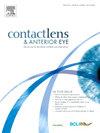Influence of scleral lens removal and reapplication on fluid reservoir thickness and visual quality after 5 h of lens wear
IF 3.7
3区 医学
Q1 OPHTHALMOLOGY
引用次数: 0
Abstract
Purpose
To assess changes in fluid reservoir (FR) thickness and optical quality following the removal and reapplication of a scleral lens worn for 5 h in participants with regular and irregular corneas.
Methods
Two groups with 10 patients were recruited: IC Group-Irregular Cornea; RC Group-Regular Cornea. Both groups were fitted with a diagnostic 16.4 mm scleral lens (hexafocon A). FR thickness was measured with optical coherence tomography (MOCEAN 4000, MOPTIM, Shenzhen Slton Technology Co. Ltd., China l), high and low contrast visual acuity was measured with ETDRS, whole eye aberrometry was assessed with IRx3 Wavefront Aberrometer (ImaginEyes, Orsay, France) for a 5 mm pupil diameter, and the light disturbance under dim light conditions was assessed with Light Distortion Analyzer (LDA, Binarytarget, Portugal). Measurements were taken at 10 min and after 5 h lens wear, as well as following lens removal and reapplication.
Results
Following lens removal and reapplication, FR thickness significantly increased in RC Group (294.3 ± 137.5 to 337.2 ± 141.4 µm, p = 0.005), and in IC Group (311.5 ± 150.3 to 339.5 ± 150.7 µm, p = 0.005, Wilcoxon). Although minor visual fluctuations of 2 letters were found in high and low contrast visual acuity, no statistically significant differences were observed after lens reapplication. Regarding the size and irregularity of light distortion, no statistically significant differences were observed in either group. The aberrometry results demonstrated significant changes, with an increase in comatic vertical aberrations (p = 0.037, Wilcoxon), observed exclusively in IC Group after lens removal and reapplication.
Conclusion
Practitioners should be aware that removing and reapplying a scleral lens with fresh saline solution will increase the FR thickness. However, this increase may not have a significant or clinically meaningful impact on visual acuity, light disturbance size or optical quality as measured by aberrometry.
巩膜晶状体摘除后再应用对晶状体磨损5h后储液层厚度和视觉质量的影响。
目的:评估正常和不规则角膜患者摘除并重新应用巩膜晶体5小时后储液层(FR)厚度和光学质量的变化。方法:选取两组10例患者:IC组不规则角膜;RC组-常规角膜。两组均安装诊断性16.4 mm巩膜晶状体(六焦a),用光学相干断层扫描(MOCEAN 4000, MOPTIM,深圳思顿科技有限公司,中国1)测量眼底厚度,用ETDRS测量高、低对比视力,用IRx3波前像差仪(ImaginEyes, Orsay,法国)评估5 mm瞳孔直径下的全眼像差,用光畸变分析仪(LDA)评估弱光条件下的光干扰。Binarytarget、葡萄牙)。在晶状体磨损10分钟和5小时后,以及在晶状体取出和重新应用后进行测量。结果:摘除晶状体后再敷后,RC组(294.3±137.5至337.2±141.4µm, p = 0.005)和IC组(311.5±150.3至339.5±150.7µm, p = 0.005, Wilcoxon)的FR厚度显著增加。虽然高、低对比视力有2个字母的轻微视觉波动,但复配后无统计学差异。在光畸变的大小和不规则性方面,两组间差异无统计学意义。像差测量结果显示了显著的变化,仅在IC组中观察到晶状体取下并重新应用后,眼内垂直像差增加(p = 0.037, Wilcoxon)。结论:从业者应该意识到,用新鲜的生理盐水溶液取出和重新应用巩膜晶状体会增加FR的厚度。然而,这种增加可能不会对视力、光干扰大小或像差法测量的光学质量产生显著或临床上有意义的影响。
本文章由计算机程序翻译,如有差异,请以英文原文为准。
求助全文
约1分钟内获得全文
求助全文
来源期刊

Contact Lens & Anterior Eye
OPHTHALMOLOGY-
CiteScore
7.60
自引率
18.80%
发文量
198
审稿时长
55 days
期刊介绍:
Contact Lens & Anterior Eye is a research-based journal covering all aspects of contact lens theory and practice, including original articles on invention and innovations, as well as the regular features of: Case Reports; Literary Reviews; Editorials; Instrumentation and Techniques and Dates of Professional Meetings.
 求助内容:
求助内容: 应助结果提醒方式:
应助结果提醒方式:


